Ijraset Journal For Research in Applied Science and Engineering Technology
- Home / Ijraset
- On This Page
- Abstract
- Introduction
- Conclusion
- References
- Copyright
Construction Planning and Scheduling of Residential Buildings Using Primavera
Authors: K Nanchari, Mohammed Ansar, Mohammed Ehtesham, Syed Naser Uddin Quadri
DOI Link: https://doi.org/10.22214/ijraset.2024.61767
Certificate: View Certificate
Abstract
For the successful completion of a project, planning and scheduling are two most important factors. The demand of the construction industry requires precise planning, scheduling, and management which can allow the overall optimization of cost, time, and resources. Due to the increase in workloads and shrinking resources public work department found new technology that helps to manage the project easily. Project management software is used as a tool for managing and organizing work which helps industries to grow rapidly. There are so many computer software are available in market now a days which is such as MSP, Primavera p6,etc…for doing project management. With the help for these software proper planning and controlling of project can be done. Primavera can easily compare the planned progress of construction work and the actual progress of the construction project. Project management software Primavera P6, includes collecting, recording, monitoring, controlling, and reporting information concerning project performance. In this study, project controlling and monitoring can be done and the causes of delays can be found.
Introduction
I. INTRODUCTION
The construction industry mainly caters to the need of providing shelter, harnessing energy and creates public access. The basic human needs have not changed over time even though the process and environment in which designers or constructors operate have become increasingly more complicated. Rapidly escalating technology has made challenging construction possible which was impossible to imagine in the previous generations. India is one of the developing countries that is concentrating on the development of new buildings and at the same time maintaining all existing buildings. The government is spending a lot of money for the new infrastructure works especially schools, hospitals, universities and low cost housing projects. With this investment, many contracting companies are being set up. At the same time, multinational companies are looking forward in exploring the construction industry in India. By looking for the expenditure of the construction industry, the project management profession is being very valuable for the construction companies to make sure the projects can be completed successfully. The project management knowledge becomes the critical part in the project because it contains the knowledge in controlling the cost, scheduling, and resources. In this Project Management field, the project manager plays very important role in the construction project. Project management professionals are responsible for ensuring the project is completed successfully, thus they need to have experience and knowledge in Project Management techniques. The construction management it may refer to the contractual arrangement under which is a firm supplies construction management services to an owner. However, in its more common use, it refers to the act of managing the construction process which is the way to manage the basic resource of construction. The resources included workers and subcontractors, Equipment and construction plant, material, money, and time. Skillful construction management results in the project completion on time and within budget. Time management is one key to effective project management. They are a few problems affect time management such as a rework activity, the change of job specification without direct notification, work overload, unreasonable time constraints, etc. The impact that from poor time management will cause delay or event worst effect mostly on cost as it is correlates to each other. As a solution to this situation planning and scheduling will be the best methods that can be used to overcome this problem. With the proper planning and scheduling it will assist the project manager in completing the project within the time and meet the aim and objective of the project. Indian Construction industry now days are facing with a lot of problem which is produce the loss of a billion ringgit. The main factor which gives the instability to the construction industry is a cost and time planning. By referring to the news in mass media the cost and the time of the project will be the first factors that lead in the uncompleted of the project or the delayed of the project. This phenomenon will cause a lot of problem to the client which is the client must do the payment back to the bank form the loan that the bank provided although the project did not complete. Cost of the project is the factor that usually may lead of the project delayed or uncompleted.
Without the proper planning the construction company may lost a lot of profit from the project and this situation may cause the project cannot finished on the time. The multi-story building construction project is the projects that involve a lot of money and using a lot of time to be complete. The construction company should planning the project cost by looking for the future because the company must predict the materials price for the future if anything situation that may lead to the increasing of the materials price occur. The loss of the profit. This is because if the construction company did not control well the usage of the source it will cause the company spend more money without following the planning cost and at the end of the project the company will lost a lot of money and sometimes the company will suffer the loss of profit in the project. The time scheduling also is the major factor that lead to the delayed or the uncompleted of the project. The construction company is facing a tough challenge in the time planning of the project because without the proper planning the time factor will cause the loss of the profit to the company. All of the construction company have planning and scheduling the time first before starting the project and some of the company did not follow well the time constraint of the project and this situation will lead the delayed of the project. Sometimes the construction companies which are planning their time for the project did not concern about the environment factor when doing the planning. The environment factor must be consider when doing the planning because the bad impact of the environment factor to the scheduling of the project will cause the delayed of the project and at the same time will make the loss of profit to the company. Thus it is important to carry a study on schedule developing for a project. Indian Construction industry now days are facing with a lot of problem which is produce the loss of a billion ringgit. The main factor which gives the instability to the construction industry is a cost and time planning. By referring to the news in mass media the cost and the time of the project will be the first factors that lead in the uncompleted of the project or the delayed of the project. This phenomenon will cause a lot of problem to the client which is the client must do the payment back to the bank form the loan that the bank provided although the project did not complete. Cost of the project is the factor that usually may lead of the project delayed or uncompleted. Without the proper planning the construction company may lost a lot of profit from the project and this situation may cause the project cannot finished on the time. The multi-story building construction project is the projects that involve a lot of money and using a lot of time to be complete. The construction company should planning the project cost by looking for the future because the company must predict the materials price for the future if anything situation that may lead to the increasing of the materials price occur. The loss of the profit. This is because if the construction company did not control well the usage of the source it will cause the company spend more money without following the planning cost and at the end of the project the company will lost a lot of money and sometimes the company will suffer the loss of profit in the project. The time scheduling also is the major factor that lead to the delayed or the uncompleted of the project. The construction company is facing a tough challenge in the time planning of the project because without the proper planning, the time factor will cause the loss of the profit to the company. All of the construction companies had planning and scheduled the time first before starting the project and some of the companies did not follow well the time constraint of the project and this situation led the delay of the project. Sometimes the construction companies which are planning their time for the project did not concern about the environment factor when doing the planning. The environmental factor must be considered when doing the planning because the bad impact of the environmental factor on the scheduling of the project will cause the delay of the project and at the same time will cause the loss of profit to the company. Thus it is important to carry out a study on schedule development for a project
II. LITERATURE REVIEW
G. Emre Gurcanli has aimed to study to give an approach for safety cost estimation for the early stages of the construction bidding phase using risk assessment activities and construction project scheduling by focusing on construction activities. Additionally, a cost analysis was performed and the results were compared and analyzed with a former project that focused on 30 concrete residential projects in Istanbul. Primavera P6 was utilized for scheduling, and risk assessment was conducted using the techniques applicable for construction projects (i.e., L matrix and Fine-Kinney). Finally, activity-based techniques were used for cost estimation. The results of this study reveal that the percentage of safety cost to the total construction cost is 1.92%. Also, to comply with the current legislation and minimize risks; 0.85 USD per man-hour should be spent according to 2013 rates and safety cost per unit area was found as approximately 5.68 USD.
Veena H C - The main aim of this study is to analyze the schedule control techniques by constraints and activity types is done using primavera P6 software for an apartment building. The project schedule control decreases the duration due to apply of constraints, level of effort, resource dependent it has an effect on the project duration. In general the purpose of project scheduler is to minimize its completion time, subject to precedence constraints. A more general version assumes that to develop one or more activities, resources such as tools, equipment, machines, or human resources are needed. In this study we can find out the different factors which affect the time and cost of a construction project.
The actual cost and time can be also reduced so that the project can be efficient. Based on a study carried out on the best features of primavera in schedule control techniques, it is concluded that primavera can be used to schedule projects and reduce project duration in construction projects.
Mullapudi Durga Sruthi – The main aim of the paper is to analyze the cost and schedule for a residential building by using earned value management. For this project, a case study is taken to known the performance and progress of the project in construction concerning the time, cost, and resources of the project. By using this technique it can be able to find and control the delays and serious issues regarding time and cost. Compared to manual calculation, Primavera is an effective way to calculate Earned Value Analysis for the projects. It certifies whether our project is on schedule and on time, on budget.
S. Ragavi – Planning and scheduling helps in future situation and implementation of the project. The Primavera Software provides user friendly options while performing any task. The cost of individual work break down can be known along with the duration. Thus decisions can be made sensibly for proper management. In multiple projects resource leveling is very important to maintain proper resource allocation. For multiple projects under a single company such analysis should be done to check out for over-allocation. Scheduling real-time projects is also an important standard for managing multiple projects.A Resource-constrained project schedule as per the site situation. For resource-constrained analysis resource leveling is arranged. Scheduling using Microsoft project Software gives good controlling and a clear schedule to a project. This project deals with scheduling using Microsoft Project.
III. METHODOLOGY
The Project Management Module is comprehensive, multi-project planning and control software built on Oracle and Microsoft SQL server relational database for enterprise-wide project management scalability. The Project Management module can stand alone for Project and resource management, or it can be used in conjunction with other products, including the Time sheets module, Methodology Management module and PRIMAVERA?s Web application. The project Management module enables organization to store and manage its projects in a central location. The module supports work breakdown structures (WBS), organizational breakdown structures (OBS), user-defined fields and codes, critical-path-method (CPM) scheduling and resource leveling.The Project Management module provides:-An enterprise project structure (EPS), which enables project managers to manage multiple projects from the highest levels of the organizations to the individuals that perform specific project tasks. Multiple users can access the same projects concurrently. Centralized resource management, including resource timesheet approval and the ability to communicate with project resources that use PRIMAVERA timesheets. Integrated risk management. Issue tracking.Management by threshold. A tracking feature that enables we to perform dynamic cross - project rollups of cost, schedule, and earned value. Work products and documents that can be assigned to activities and managed centrally. A report wizard that helps we create customized reports to extract any data from the project management database. project management software that enables us budget, prioritize, plan, administer and manage multiple projects; optimize limited, shared resources; control changes and consistently move projects to on-time and on-budget completion. It provides customizable interfaces, scalable and flexible tools and easy integration with project management software, including PRIMAVERA?s contract manager software and Microsoft project. PRIMAVERA provides simple data exchange with Microsoft excel and Microsoft project, as well as other PRIMAVERA applications such as contract manager (expeditions), methodology management, p6 and contractor.
A. Methodology Management (MM)
The methodology management module is a system for authoring and storing methodologies or project plan templates. By using the methodology module, our organization can gather it “best practices” and store them in a central location; this allows project manager to create custom project plans by selecting, combining, and tailoring methodologies, rather than creating project plans from scratch for each new project. In this way, the organization can continually improve and refine methodology activities, estimates and other information with each new project.
B. Time Sheet (TS)
PRIMAVERA also provides a web- based inter -project communication and time keeping system. As a team - level tool for project participants, Time sheets helps team member focus on the work at and with a simple cross - project to -do list of their upcoming assignments. It also provide views of project changes and time cards for manager approval .Because team member use this module to enter up to a minute information about their assignments and record time against their work load, project leaders can make crucial project decisions with the confidence that they have the most current information possible.
C. PRIMAVERA’s web Application
The PRIMAVERA web application provides browser-based access to project, portfolio and resources data across the organization .Every web user can create customized dashboards that provide an individualized and focused view of the specific projects and categories of project data that are most relevant to their role in managing project portfolios, project and resources. Project workspaces and workgroups extend the model of customizable, focused data views by enabling designated project team members to create a uniform team view of data that relates to one specific project or to a subset of activities within a project. The PRIMAVERA web application provides access to a wide range of data views and features that’s enables web users to manage their projects from initial concept review and approval through to completion.
D. Features in PRIMAVERA Project Management
Manually plan future period resource allocation in the resource usage spreadsheet of the resource assignments and activities windows. When work on an activities is planned to be performed sporadically or at varying level of effort, we can manually enter future period budgeted units or remaining units to reflect the plan more accurately than define resource curve. We can define role availability (limits) over time in the roles dictionary. A new user preference enables us to specify how we want to calculate role limits: by using the limits of the role’s primary resource or by using the role limits we define. When we choose to define role limits and calculate role availability using the defined limits, we can view the role limit and allocation limit in spreadsheets, charts. And histograms that display role data in both the project management module and the PRIMAVERA web application. Assign user interface views to users on the Global access tab of the users dialog box. User interface views are customized views of the PRIMAVERA web application that enable and disable access to PRIMAVERA web application functionality. We can only create user interface views in the PRIMAVERA web application. The new global privilege. Edit User Interface views? controls who can create, edit, delete and assign views. Create a reflection of an active project. A reflection in a copy of an active project that contains a link to the original project. This allows us to make changes to the reflection and then merge selected changes back into to the original project, keeping active project data such as timesheet information intact. A new activity attribute called Owner enables organization to specify one person responsible for an activity. The option to designate an Activity’s owner is of particular use for organizations who want to collect activity progress information from project team members who are not assigned resources or time sheets users because it can be combined with the appropriate PRIMAVERA license to enable status reporting. Specifically, a user who has a team member license and the appropriate OBS project access and security privileges can use the PRIMAVERA?s web application to update progress for activities they are associated with as Activity Owner. Additionally, to support oversight and approval processes, the Activity owner designation can be combined with the use of the new Reflection project feature, which offers the capability to review all the changes and specify which, if any, should be merged into the active source project associated with reflection. The new Time sheets license provides access to the timesheets application only. In previous version, user required a Team member license to access timesheets. The existing team member license still provides access to the timesheets, but has been enhanced to provide additional functionality in the PRIMAVERA web application, such as adding/editing activity relationship, activity expenses, and user- defined fields. For users who require access to the PRIMAVERA web application to update data for their projects as well as access to timesheets, we can assign team member license; for user who only require access to the timesheets to report their time, we can assign the timesheets license. Import and export projects between project Management modules in XML format. The new project privileges „Edit Resource Assignments for Resource planning? and edit role Assignments for Resource planning “control who can assign, delete, and modify resource/role assignments on a project or WBS level in PRIMAVERA?s web resource management application. The new project privilege „Edit committed flag for Resource planning? controls who can identify committed resource and role assignments on a project or WBS level in the resource planning view in PRIMAVERA?s web resource management application. The new Global privilege „Edit Global scenarios? controls who can create ,edit, and Delete global scenarios in PRIMAVERA?s web portfolio Management Module. The new global privilege „Edit Global Dashboards “controls who can create,edit,and delete global dashboards in the PRIMAVERA web application. Users with this privilege can create dashboards in the PRIMAVERA web application users, and specify the content and lower of all global dashboards; all PRIMAVERA web application users can create personal dashboards available only to them, or to specific users. Two new project-level options let we specify if timesheets users can: (1) view activities that belong to inactive projects (2) report that they have completed work for an assignment. These options appear on the project details Resource lab. Two new administrative preferences let we specify global level options related to timesheets. We can choose whether to allow resources to assign themselves to activities and whether to allow resources to report time against completed activities and assignments. The global option to allow resources to assign themselves to activities can be overridden for individual projects on the project details resources tab. In the resource assignments window and on the activity details resource tab, we can add columns that display the date an assignment was made the PRIMAVERA login name of the person who made the assignment. These columns are available under the general category in the customize columns dialog box. Curtains and spotlights in the p6 are now associated with the lowest. In the previous versions of the software, these items our associated with the project. When database are upgraded to p6,all curtains and spotlights that are saved with the open lower will be displayed regardless of which project is open.
IV. STEPS INVOLVED IN PRIMAVERA
???????A. Defining the EPS
All projects in the enterprise exist within the EPS hierarchy, a graphical representation of the project structure. The levels and structure of the company’s EPS depend on the scope of the projects and how we want to summarize data. We can define one or multiple root bodes, up to 50 combined WBS/EPS levels and as many projects as necessary to complete the required work set forth by the operations executive and project managers in the organization. Before we begin defining our company’s EPS, we should become familiar with the structures and procedures established for our enterprise, such as codes, calendars, and other company-wide standards. Once the EPS hierarchy is defined, we can begin to develop projects by adding information, activities and resources.

???????B. Work Breakdown Structure (WBS)
A WBS is a hierarchy of work that must be accomplished to complete a project, which defines a product or service to be produced. The WBS is structured in levels of work detail. Beginning with the deliverable itself, and is then separated into identifiable work elements.Each project has its own WBS hierarchy with the top level WBS element being equal to that of each EPS node or project; Each WBS element may contain more detailed WBS levels, activities, or both. When creating a project, the project manager typically develops the WBS first, assigns documentation to each WBS element, and then defines activities for performing the elements work. In addition to the document and activity assignments, each WBS element also has a assigned calendar. Specific earned value calculation settings, and an assigned OBS element responsible for all work included in the WBS element. Using a WBS at the planning stages of a project is beneficial for top-down estimations and summary rollups of data not yet associated with projects. The WBS hierarchy can contain anticipated dates, planned budgets, and summary values. Financial information is used interchangeably between projects and their WBS elements. so we can use the pre-established budget amounts and funding information we ser for WBS elements immediately for their project and activity counterparts. The budget and spending plan can stand alone to represent financial data for the WBS level. Or it can reflect the budget distribution data established for the project. Summary information can be rolled up to any WBS level we specify.
???????C. Organizational Breakdown Structure (OBS)
The organization break down structure (OBS) is a global hierarchy that represents the managers responsible for the project in our enterprise. The OBS usually reflects the management structure of our organization, from top-level personnel down through the various levels constituting our business. We can associate the responsible managers with their areas of their EPS either nodes or individual projects. When we associate a responsible manager with an EPS node, any projects we add to that branch of the EPS are assigned those manager elements by default. The OBS hierarchy is also used to grant users specific access privileges to projects and the WBS levels within projects.
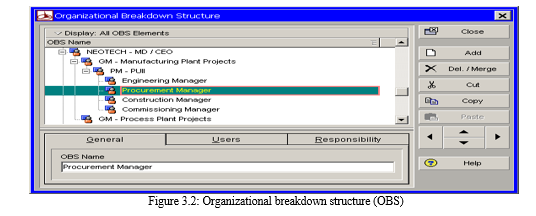
???????D. OBS Security
Project profiles define a user’s access to each project according to a specified OBS element. The specified OBS elements determine which work breakdown structure (WBS) elements, activities, risks, issues, and thresholds the user can edit in a project.
The OBS is a global hierarchy that represents the management responsible for the projects in our enterprise. The OBS hierarchy is used primarily to grant users specific access privileges to projects and to the WBS levels within projects. To access a project, a user must have access permissions for an OBS element within the project. This provides user access to WBS information for which the specified OBS element is responsible, as well as limits user’s access to WBS information that may lie beyond the user’s scope. Profiles and corresponding privileges are preset using the security profiles dialog box and are associated with the log in name of the user. When we assign users to OBS elements using their log in names, the security profile is automatically associated.
V. PROJECT CODES AND VALUES
Set of codes to organize the projects in the EPS in groups according to specific categories. We can then do filtering, sorting, grouping and reporting to our projects. Use project codes to group projects; consolidate large amounts of information, and to distinguish one project from another. All projects assigned a value for a code is grouped by their corresponding values when we group and sort by project code. Any projects not assigned a Value for the project codes are placed at the bottom of the view under a No code grouping band.
Project codes and values
|
Project code |
project code weight |
project code value |
project code value weight |
|
A project code is used to represent project evaluation criteria |
The weight of the project code reflects the importance of the criteria to decision making |
A project code value is used to represent an attribute of the corresponding project code |
The weight of the project code value reflects the ranking of the attribute concerning the evaluation criteria. |
|
Examples |
|
|
|
|
Projected sales |
10 |
Low potential Mid.potential High potential |
1 2 3 |
If the projected sales project code is assigned to project A with a project code value of high potential, the non-normalized score for project A=50.If the projected sales project code is assigned to project A with a project value of Low potential, the non-normalized score for project A=10.
A. Global and Project Calendars
The calendar can be created and assigned calendars to each resource and each activity. These calendars define the available work hours in each calendar day. We can also specify national holidays, our organization's holidays. Project-specific work/nonwork holidays, and resource vacation days. Calendar assignments are used for activity scheduling, tracking and source leveling. Whether an activity uses its assigned calendar or the calendar of an assigned resource depends on the activity type we specify. There calendar pools are defined as global, resource, and project. The global calendar poll contains calendars that apply to all projects. The project calendar proof separates pool of calendars for each project. The resource calendar proof can be a separate pool of calendars for each resource. We can assign either resource or global calendars to resources, and we can assign either global or project calendars to activities. The resource and project calendars can link to global calendars. Then, if we make changes to a global calendar, our changes apply to all resource and project calendars that are linked to the modified global calendar.
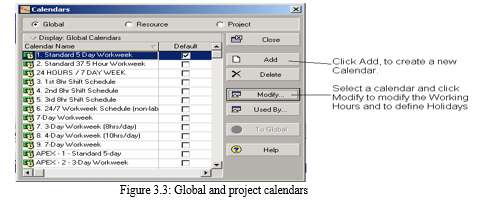
B. Activity Codes and Values
Activity codes and values enable us to filter,group,sort and report activity information accordingly to our organization’s unique requirements. For example, if our organization has more than one location, we can create a location code with values such as Chennai, Mumbai and Delhi. We can then associate activities with a specific location such as Chennai. We can define three types of activity codes, Global (for all projects in the EPS),EPS(for projects within selected EPS) and project (for opened project only),Each activity code can have an unlimited number of values.
C. Assigning OBS Element to WBS
Assign the OBS element to the WBS level by clicking on “Responsible Manager” option. Given following is the list of OBS elements to be assigned to the WBS levels.
D. Budget and Establishing Spending Plan
We can create budget estimates for each EPS nodes, project, or WBS level and then refine them as needed .Use the budget log tab on the projects window to enter the original budget the total amount we require for the EPS node or project. The budget change log helps us to keep track of budget changes as occur.
The current budget (original budget plus approved budget changes) and proposed budget fields (original budget plus approved and pending budget amount) incorporate these changes so we have up-to-date and accurate budget information for each projector EPS node. The spending plan tally column shows any amount previously recorded for loud-level project spending plans. The current variance is the different between the monthly spending of the EPS node and its projects tallies. We can type the benefit amount or profit portion of the monthly amounts; the benefit plan is also tallied.
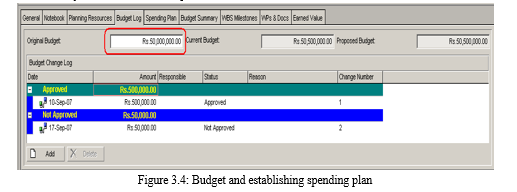
E. Work Products and Documents
The work products and documents feature enables us to cat-log and track all project-related document and deliverables. This includes guidelines, procedures, standards, plans, design, templates, worksheets and all types of project deliverables. A work product or document can provide standards and guidelines for performing an activity’s work, or it can be formally identified as a project standard. A work product or document can also be activity output, such as testing plans and blueprints. We can also use the work products and documents feature to identify project deliverables, documents that will be delivered to the end user or customer at the end of project. With the project management module, we can assign work products and documents to activities and to work breakdown structure (WBS) elements. During a project’s early planning stages, we can assign the same work product or document to one or more activities as our project’s activity details develop. The work products and documents feature enables us to maintain general information about project documents, such as revision date, location, and author. The actual document file can be stored on a network file server, configuration management system, or web site, depending on project Web site, depending on
project requirements. We can specify a public or private location for the document file. Specifying a public location enables resource to view the document through timesheets, when we specify a public location, primary resources can launch the work product or document in its native application to make revisions as needed
F. Activities, Relationship and scheduling
Activity is the fundamental work elements of a project. They are the lowest level of a work breakdown structure (WBS) and, as such, are the smallest subdivision of a project that directly concerns the project manager. Although we can divide activities into steps, an activity primary’s primary resource is typically responsible for managing and tracking the progress of an activity’s steps, while the project manager is typically responsible for managing and tracking the progress of the overall activity.
VI. RELATIONSHIP
A relationship defines how an activity relates to the start or finish of another activity or assignment. Add relationships between activities to create a path through our schedule from the first activity to the last activity. These relationships, which from the logic of the project network, are used together with activity durations to determine schedule dates. An activity can have as many relationships as necessary to model the work that must be done.
A. Relationship Types
- Finish to start
- Finish to finish
- Start to start
- Start to finish
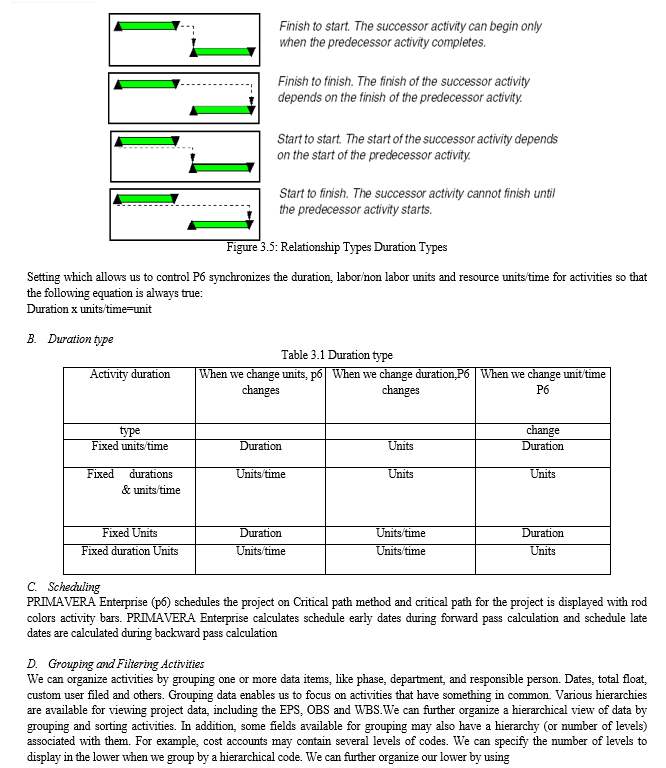
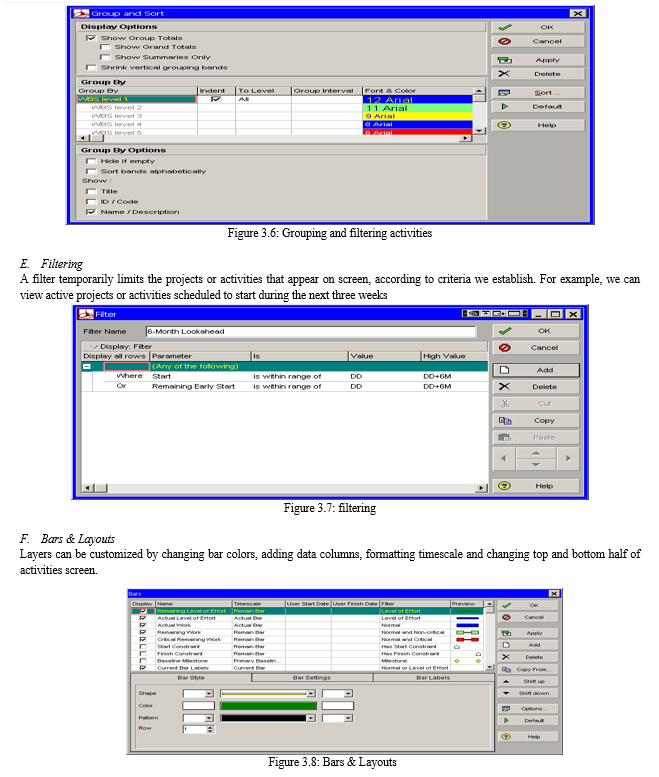
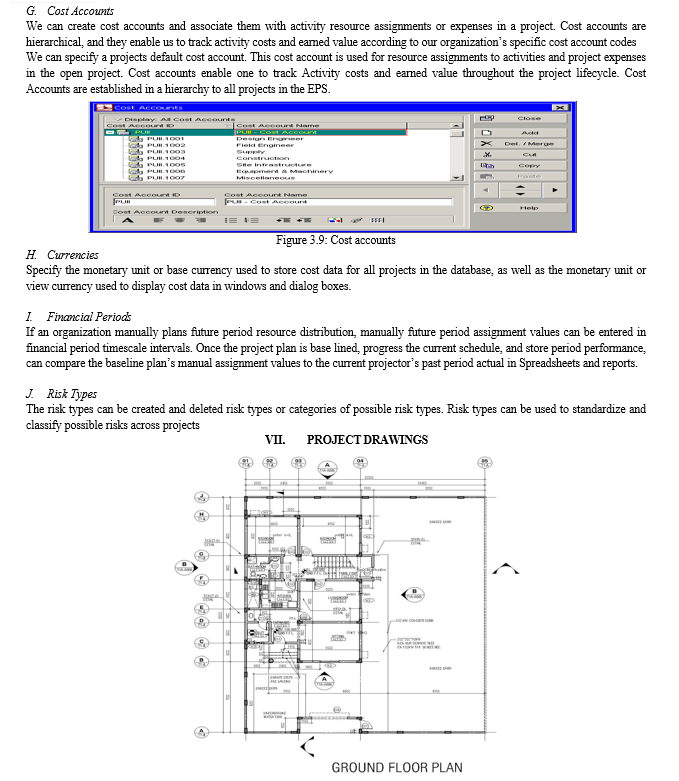
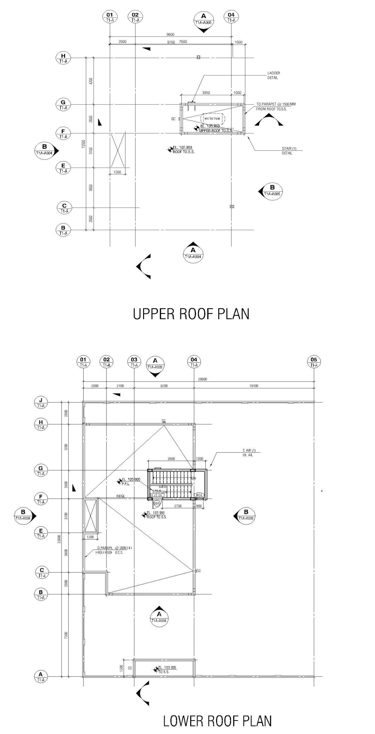 ???????
???????
Conclusion
The Critical Path Network of the ROYAL PALACE VILLA being built at ATTAPUR is obtained using the planning and scheduling software PRIMAVERA P6. The activities required to complete the building was identified and were fed as input into the PRIMAVERA. The duration of the activities were determined depending on the quantity and type of work to be done and the available resources. The predecessors and successors of the activities were also defined. After s c h e d u l i n g the critical path and project duration are obtained. The scheduled network was then analyzed and a classic schedule report was generated using PRIMAVERA. Therefore an attempt is made in arriving at an optimum network diagram that will go at least a step towards minimizing the time and cost overruns which will play a crucial role in this present competitive and globalized environment. This project intends to make an attempt in this direction.This project has helped us to have a comprehensive study in the areas relating to planning, scheduling and controlling of projects. It has also helped us to gain knowledge about other fundamental principles and techniques of construction project management. As an important milestone in our learning process is the acquisition of k n o w l e d g e about the software tool PRIMAVERA P6, which is being most widely and globally used. Facing the challenges of real life construction management will no longer be a difficult one.
References
[1] Cook B., Williams, and P. 2004. Construction Planning, Programming and Control. Oxford, Blackwell Publishing Ltd: 442 p. [2] Ahuha, HN. Dozzi, S. Abourizk, M. Project Management, Techniques in Planning and Controlling Construction Projects. New York: Wiley & Sons Inc, 1994. [3] Wideman, M.R. The Role of the Project Life Cycle in Project Management.www.maxwideman.com. 2004. [4] Ahuha, H.N. Dozzi, S. Abourizk, M. Project Management, Techniques in Planning and Controlling Construction Projects. New York: Wiley & Sons Inc, 1994. [5] Project Management Journal is published by John Wiley & Sons in partnership with PMI. International Journal of Project Management Volume 22; Number 2, February 2004. [6] International Journal of Project Management Vol. 17, No. 6, pp. 337±342, 1999 [7] International Journal of Project Management 23 (2005) 181–192. [8] Project Management: A Systems Approach to Planning, Scheduling and Controlling by Harold Kerzner - 6th Edition - 1152 pages - Published Aug. 1997 [9] Empowering project portfolio managers: How management involvement impacts project portfolio management performance - International Journal of Project Management 28 (2010) 818–831. [10] Construction planning and Management – PS GAHLOT, B.M.DHIR. [11] PERT and CPM: Principles and application – Srinath l.s, East-west press, 1975. [12] PERT and CPM – Punmia B.C, and Khandewal, Lakshmi publications, 1990. [13] Construction and Management- Weley Eastern Ltd, 1992.
Copyright
Copyright © 2024 K Nanchari, Mohammed Ansar, Mohammed Ehtesham, Syed Naser Uddin Quadri. This is an open access article distributed under the Creative Commons Attribution License, which permits unrestricted use, distribution, and reproduction in any medium, provided the original work is properly cited.

Download Paper
Paper Id : IJRASET61767
Publish Date : 2024-05-07
ISSN : 2321-9653
Publisher Name : IJRASET
DOI Link : Click Here
 Submit Paper Online
Submit Paper Online

